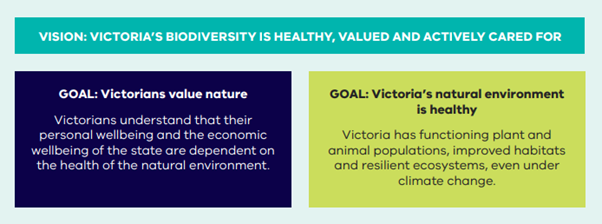Australian
Environment Protection and Biodiversity Conservation Act 1999 Act
The Federal Environment Protection and Biodiversity Conservation Act 1999 (EPBC Act) identifies ‘matter of national environmental significance,’(MNES) including RAMSAR wetlands, threatened species and ecological communities. If an action is likely to have a significant impact on a MNES, it must be referred to the Department of Environment and Energy under this Act, to determine if it can proceed. The north central region includes:
- The Gunbower Forest and the Kerang Wetlands RAMSAR wetlands.
- Several threatened species and threatened ecological communities listed under the EPBC Act.
Threatened Species Strategy 2021-31
The Australian Government invests in threatened species programs in the region. Going forward, this will be guided by priorities identified in the recently renewed Threatened Species Strategy 2021-31
Two high-level objectives will guide the direction of the strategy:
- To improve the trajectories of priority threatened species by 2031.
- To improve the condition of priority places by 2031.
The new place-based objective extends the focus of the previous strategy to threat mitigation and habitat protection efforts across landscapes, providing location-specific support for threatened ecological communities and many threatened species.
Victorian
Protecting Victoria’s Environment ‐ Biodiversity 2037
Protecting Victoria’s Environment – Biodiversity 2037 (Biodiversity 2037) was launched in 2017 and gazetted as the new Flora and Fauna Strategy, a requirement of the Flora & Fauna Guarantee Act 1988. Biodiversity 2037 is a high-level strategy which recognises that stopping the decline of Victoria’s biodiversity will not be achieved overnight. It contains ambitious targets that will require a concerted effort over many years by government and its partners across Victoria to put biodiversity back on a path to recovery. The vision and goals of Biodiversity 2037 are outlined below:

Biodiversity 2037 outlines a number of priorities and associated initiatives to reach these goals. Priority directions and outcomes in the biodiversity and community sections of this RCS outline how Biodiversity 2037 priorities will be implemented in the region and how we will contribute to the overall statewide targets.
Flora and Fauna Guarantee Act 1988
The Flora and Fauna Guarantee Act 1988 provides for the listing of threatened species, threatened communities and potentially threatening processes. The Flora and Fauna Guarantee Amendment Act 2019 came into effect on June 1, 2020, which aims to improve the implementation and enforcement of the Act including; consideration of the rights and interests of Traditional Owners and the impacts of climate change…consideration of biodiversity across government…clarifies existing powers to determine critical habitat.. gives effect to a consistent national approach to assessing and listing threatened species… modernises the FFG Act’s enforcement framework. The FFG Act requires that a Biodiversity Strategy is prepared which includes proposals for achieving the objectives of the Act, targets to measure the achievement of the objectives and a monitoring, evaluation and reporting framework. Protecting Victoria’s Environment – Biodiversity 2037 is the current Biodiversity Strategy under the FFG Act.
Victorian Planning Provisions
The Victoria Planning Provisions are the standard provisions for all of Victoria’s planning schemes. Local Government Planning Schemes have a key role in regulating development. Through strategic application of zones and overlays (e.g. Vegetation Protection Overlays or Environmental Significance Overlays) development can be excluded from sensitive areas and or impacts can be managed through permits, referrals and conditions.
Native vegetation removal regulations are primarily implemented through planning schemes. Guidelines for the removal, destruction or lopping of native vegetation 2017 outline how native vegetation removal is assessed and offset. These guidelines are an incorporated document in all Victorian planning schemes.
Regional
Biodiversity Response Planning
Biodiversity Response Planning (BDP) is a long term, place-based planning approach to biodiversity conservation designed to strengthen alignment, engagement and participation between government, Traditional Owners, non-government agencies (NGOs) and the community. It is the process DELWP are using to implement Protecting Victoria’s Environment – Biodiversity 2037.
During 2019-20 regional DELWP worked with stakeholders to better understand local threats, action and gaps and to identify priorities including Focus Landscapes. Fact sheets have been developed for each Focus Landscape.
BRP will be an ongoing process, with priorities refined and reviewed over time based on; new information, stakeholder drivers, policy changes and landscape events.
Bushfire Management Strategies
There are two regional Bushfire Management Strategies that apply to the north central region; the Grampians (for Northern Grampians, Pyrenees and Hepburn Shires) and the Loddon Mallee (for the rest of the region). Different zones are identified according to the relative risk to people and property, with communities most at-risk in the south-eastern part of the region. For some zones the priority is to protect human life whereas others are managed for ecological outcomes. Tolerable Fire Interval and Vegetation Growth Stage Structure are used as indicators of ecosystem resilience to fire.


